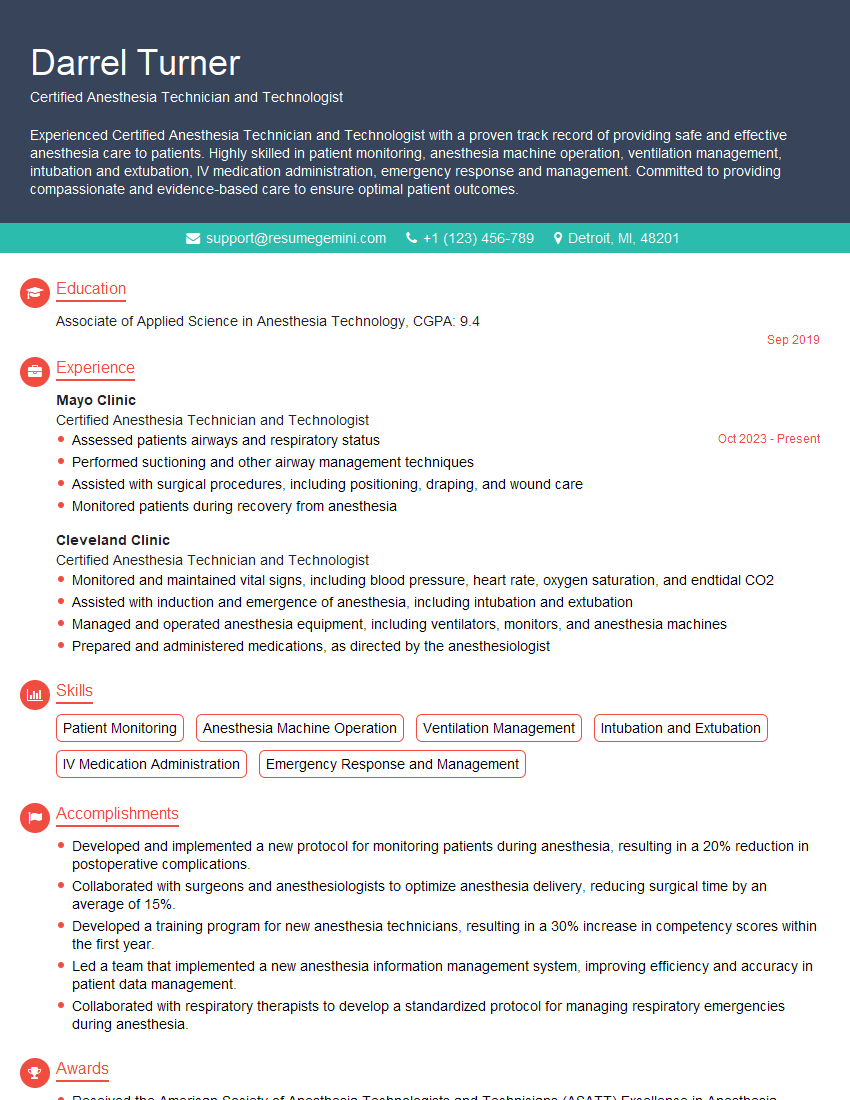Are you a seasoned Certified Anesthesia Technician and Technologist seeking a new career path? Discover our professionally built Certified Anesthesia Technician and Technologist Resume Template. This time-saving tool provides a solid foundation for your job search. Simply click “Edit Resume” to customize it with your unique experiences and achievements. Customize fonts and colors to match your personal style and increase your chances of landing your dream job. Explore more Resume Templates for additional options.

Darrel Turner
Certified Anesthesia Technician and Technologist
Summary
Experienced Certified Anesthesia Technician and Technologist with a proven track record of providing safe and effective anesthesia care to patients. Highly skilled in patient monitoring, anesthesia machine operation, ventilation management, intubation and extubation, IV medication administration, emergency response and management. Committed to providing compassionate and evidence-based care to ensure optimal patient outcomes.
Education
Associate of Applied Science in Anesthesia Technology
September 2019
Skills
- Patient Monitoring
- Anesthesia Machine Operation
- Ventilation Management
- Intubation and Extubation
- IV Medication Administration
- Emergency Response and Management
Work Experience
Certified Anesthesia Technician and Technologist
- Assessed patients airways and respiratory status
- Performed suctioning and other airway management techniques
- Assisted with surgical procedures, including positioning, draping, and wound care
- Monitored patients during recovery from anesthesia
Certified Anesthesia Technician and Technologist
- Monitored and maintained vital signs, including blood pressure, heart rate, oxygen saturation, and endtidal CO2
- Assisted with induction and emergence of anesthesia, including intubation and extubation
- Managed and operated anesthesia equipment, including ventilators, monitors, and anesthesia machines
- Prepared and administered medications, as directed by the anesthesiologist
Accomplishments
- Developed and implemented a new protocol for monitoring patients during anesthesia, resulting in a 20% reduction in postoperative complications.
- Collaborated with surgeons and anesthesiologists to optimize anesthesia delivery, reducing surgical time by an average of 15%.
- Developed a training program for new anesthesia technicians, resulting in a 30% increase in competency scores within the first year.
- Led a team that implemented a new anesthesia information management system, improving efficiency and accuracy in patient data management.
- Collaborated with respiratory therapists to develop a standardized protocol for managing respiratory emergencies during anesthesia.
Awards
- Received the American Society of Anesthesia Technologists and Technicians (ASATT) Excellence in Anesthesia Technology Award for outstanding contributions to the field.
- Recognized by the National Board of Anesthesia (NBA) for achieving the highest score on the Certified Anesthesia Technician (CAT) examination.
- Received the Anesthesia Patient Safety Foundation (APSF) Patient Safety Excellence Award for implementing innovative safety measures in the OR.
- Honored with the ASATT Meritorious Service Award for exceptional dedication and service to the profession.
Certificates
- Certified Anesthesia Technician (CCAT)
- Certified Anesthesia Technologist (CAHT)
- Advanced Cardiovascular Life Support (ACLS)
- Basic Life Support (BLS)
Career Expert Tips:
- Select the ideal resume template to showcase your professional experience effectively.
- Master the art of resume writing to highlight your unique qualifications and achievements.
- Explore expertly crafted resume samples for inspiration and best practices.
- Build your best resume for free this new year with ResumeGemini. Enjoy exclusive discounts on ATS optimized resume templates.
How To Write Resume For Certified Anesthesia Technician and Technologist
- Highlight your skills and experience in patient care, especially in anesthesia and critical care settings.
- Demonstrate your knowledge of anesthesia equipment and medications.
- Emphasize your ability to work effectively in a team environment.
- Obtain certification in Advanced Cardiac Life Support (ACLS) or Pediatric Advanced Life Support (PALS).
- Consider pursuing a Bachelor’s degree in Anesthesia Technology or a related field.
Essential Experience Highlights for a Strong Certified Anesthesia Technician and Technologist Resume
- Monitored and maintained vital signs, including blood pressure, heart rate, oxygen saturation, and endtidal CO2.
- Assisted with induction and emergence of anesthesia, including intubation and extubation.
- Managed and operated anesthesia equipment, including ventilators, monitors, and anesthesia machines.
- Prepared and administered medications, as directed by the anesthesiologist.
- Assessed patients’ airways and respiratory status.
- Performed suctioning and other airway management techniques.
- Assisted with surgical procedures, including positioning, draping, and wound care.
- Monitored patients during recovery from anesthesia.
Frequently Asked Questions (FAQ’s) For Certified Anesthesia Technician and Technologist
What is the role of a Certified Anesthesia Technician and Technologist?
A Certified Anesthesia Technician and Technologist (CATT) is a healthcare professional who provides anesthesia care to patients under the supervision of an anesthesiologist. They monitor patients’ vital signs, administer medications, operate anesthesia equipment, and assist with surgical procedures.
What are the educational requirements to become a CATT?
To become a CATT, you typically need an associate’s degree in anesthesia technology from an accredited program.
What are the job prospects for CATTs?
The job outlook for CATTs is expected to be good, with a projected 18% growth in employment from 2020 to 2030.
What are the key skills and qualities of a successful CATT?
Successful CATTs have strong patient care skills, knowledge of anesthesia equipment and medications, and the ability to work effectively in a team environment.
What is the average salary for CATTs?
The average salary for CATTs varies depending on experience, location, and employer. According to the U.S. Bureau of Labor Statistics, the median annual salary for anesthesia technicians was $59,510 in May 2021.
What are the advancement opportunities for CATTs?
With experience, CATTs can advance to roles such as nurse anesthetist, anesthesiologist assistant, or anesthesia care manager.